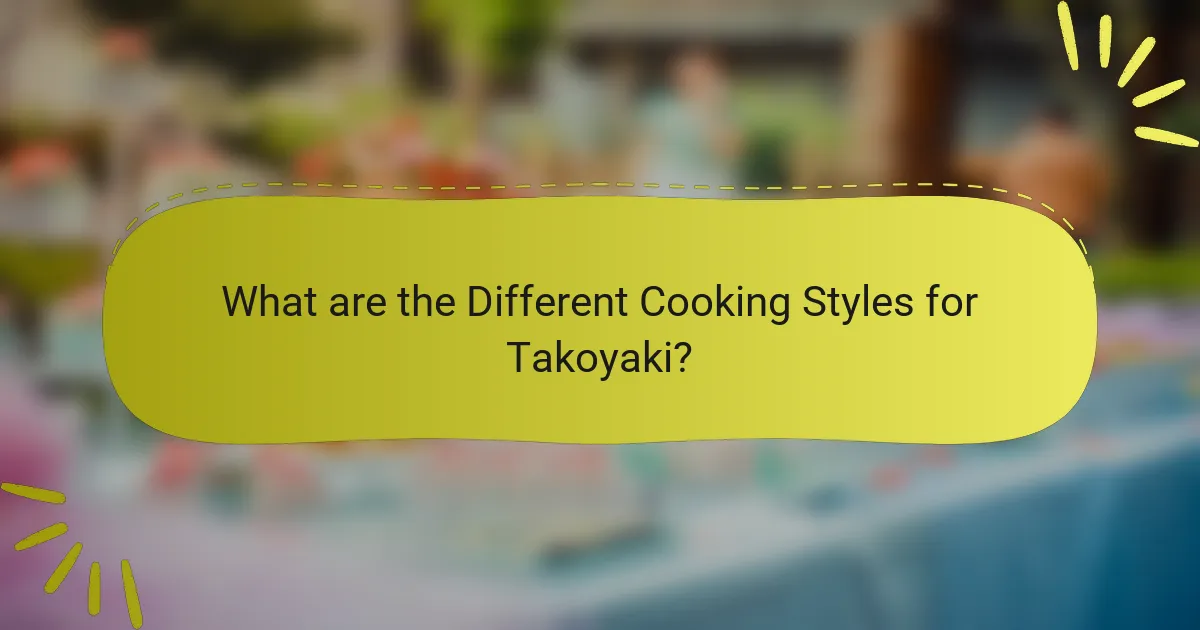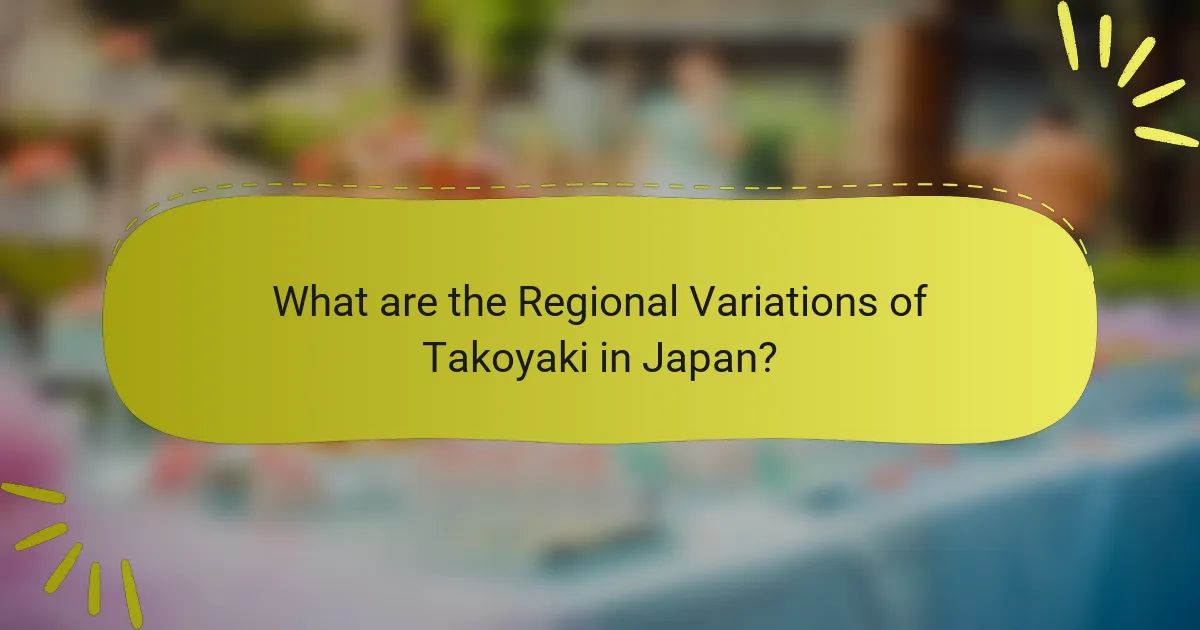Takoyaki is a traditional Japanese street food originating from Osaka, characterized by small, round balls made from a wheat flour-based batter filled with diced octopus and other ingredients. This article explores the various ingredients, cooking styles, and regional variations of takoyaki, highlighting its cultural significance in Japan. Different cooking methods, such as using specialized grills or frying pans, influence the texture and flavor of the dish. Additionally, regional adaptations across Japan showcase unique ingredients and preparation techniques, reflecting local culinary identities and preferences. Through this examination, the article provides a comprehensive understanding of takoyaki’s role in Japanese cuisine and its growing international popularity.

What is Takoyaki and its Cultural Significance?
Takoyaki is a popular Japanese street food consisting of small, round balls made from a wheat flour-based batter filled with diced octopus, tempura scraps, pickled ginger, and green onions. This dish originated in Osaka in the early 20th century and has since become a staple in Japanese cuisine. Takoyaki is often cooked in a special molded pan that gives it its characteristic shape. It is typically served hot and topped with takoyaki sauce, bonito flakes, and aonori (seaweed flakes).
Culturally, takoyaki holds significant importance in Japan as a symbol of Osaka’s culinary identity. It is commonly enjoyed at festivals and street fairs, reflecting the communal and festive spirit of Japanese culture. Takoyaki has also gained international popularity, showcasing Japan’s rich food culture to the world. The dish represents the fusion of flavors and techniques that characterize regional Japanese cuisine.
How did Takoyaki originate in Japan?
Takoyaki originated in Osaka, Japan, in the early 20th century. It was created by street vendors who sought to offer a new snack. The dish consists of batter filled with diced octopus, tempura scraps, and green onions. Takoyaki is cooked in a special molded pan that gives it its distinctive shape. The original recipe is attributed to a vendor named Tomekichi Endo. He popularized the dish at a local festival. Over time, Takoyaki became a staple of Japanese street food culture. Today, it is enjoyed across Japan and internationally.
What historical events influenced the creation of Takoyaki?
Takoyaki originated in Osaka, Japan, during the early 20th century. The dish was influenced by the popularity of street food in Japan. The introduction of Western-style cooking techniques also played a role. In 1935, a vendor named Tomekichi Endo began selling takoyaki at a stall. He adapted a recipe from a similar dish called akashiyaki, which used octopus. The use of a special molded pan became essential for its preparation. The dish quickly gained popularity among locals and tourists alike. By the 1950s, takoyaki had become a staple of Japanese street food culture. Its historical roots reflect a blend of local ingredients and culinary innovation.
Why is Takoyaki considered a popular street food?
Takoyaki is considered a popular street food due to its delicious flavor and convenience. It is made from a batter filled with diced octopus, tempura scraps, and green onions. The dish is cooked in a special molded pan, creating crispy spheres. Takoyaki is often served hot and topped with savory sauces and bonito flakes. Its quick preparation makes it ideal for street vendors. The dish is also affordable, attracting a wide range of customers. Takoyaki is widely enjoyed at festivals and food markets in Japan, enhancing its popularity.
What are the key ingredients in Takoyaki?
The key ingredients in Takoyaki are flour, dashi, eggs, and octopus. Takoyaki batter is primarily made from wheat flour and is mixed with dashi, a Japanese soup stock. Eggs are added to enhance the texture and flavor of the batter. The main filling consists of diced octopus, which is the defining feature of the dish. Additional ingredients include green onions, pickled ginger, and tempura scraps, which add flavor and texture. Takoyaki is typically topped with takoyaki sauce, mayonnaise, bonito flakes, and aonori for added taste and presentation. These ingredients combine to create the unique flavor profile of Takoyaki.
What is the primary ingredient used in Takoyaki?
The primary ingredient used in Takoyaki is diced octopus. Takoyaki is a popular Japanese street food. It consists of a batter made primarily from flour, eggs, and dashi. The diced octopus is mixed into this batter. Other ingredients may include green onions and pickled ginger, but octopus is the defining element. Its inclusion provides the characteristic flavor and texture of Takoyaki.
How do different ingredients affect the flavor of Takoyaki?
Different ingredients significantly influence the flavor of Takoyaki. The primary ingredient is the batter, typically made from flour, dashi, and eggs. This base provides a savory umami flavor. Adding octopus enhances the dish with a briny taste. Green onions contribute a fresh, mild sweetness.
Furthermore, pickled ginger adds a tangy kick. Tenkasu, or tempura scraps, introduces a crunchy texture and additional flavor depth. Various sauces, like takoyaki sauce and mayonnaise, add sweetness and creaminess. Finally, toppings like bonito flakes and seaweed provide umami and aromatic elements.
Each ingredient uniquely alters the overall flavor profile, creating a diverse culinary experience. The combination of these ingredients allows for regional variations, showcasing local tastes and preferences in Takoyaki.

What are the Different Cooking Styles for Takoyaki?
Takoyaki can be prepared using various cooking styles. The most common style is using a specialized takoyaki grill, which has round molds. This method allows for even cooking and a crispy exterior. Another style involves using a non-stick frying pan, which can create a similar effect but may require more attention. Some chefs opt for deep-frying takoyaki for a different texture. Additionally, baking in an oven is also an alternative, although it may lead to a softer result. Each cooking style influences the flavor and texture of the final product. The traditional takoyaki grill remains the most popular choice among street vendors in Japan.
How is traditional Takoyaki prepared?
Traditional Takoyaki is prepared by mixing a batter of flour, dashi, and eggs. This batter is poured into a special Takoyaki pan with half-spherical molds. Chopped octopus, green onions, and pickled ginger are added to each mold. The batter is then cooked until golden brown, typically for about three to five minutes. Using a skewer, the balls are turned to ensure even cooking. Once cooked, Takoyaki is often topped with takoyaki sauce, bonito flakes, and aonori. This cooking method is rooted in Osaka’s street food culture, dating back to the 1930s.
What equipment is essential for making Takoyaki?
The essential equipment for making Takoyaki includes a Takoyaki grill pan, a ladle, and skewers. The Takoyaki grill pan has specific round molds for cooking the batter. A ladle is necessary for pouring the batter into the molds evenly. Skewers are used to turn the Takoyaki balls while cooking. These tools are crucial for achieving the traditional shape and texture of Takoyaki. Without them, it is challenging to create the dish effectively.
What techniques are used to achieve the perfect Takoyaki?
To achieve the perfect Takoyaki, a few key techniques are essential. First, using a well-balanced batter is crucial. The batter should be light and airy, typically made from flour, dashi, and eggs. Second, the temperature of the Takoyaki grill must be controlled. It should be hot enough to create a crispy exterior while cooking the inside thoroughly. Third, proper flipping technique is important. Using a pick or skewer, the batter balls should be turned at the right moment to ensure even cooking. Fourth, the addition of fillings like octopus, green onion, and pickled ginger should be done generously. This enhances the flavor profile of the Takoyaki. Finally, serving Takoyaki with toppings like takoyaki sauce, bonito flakes, and mayonnaise adds to the overall experience. These techniques are widely recognized in Takoyaki preparation, contributing to its popularity in Japanese cuisine.
What modern variations of Takoyaki exist?
Modern variations of Takoyaki include ingredients such as cheese, shrimp, and vegetables. Some versions incorporate spicy sauces or different types of seafood. Others may feature unique toppings like mayonnaise, bonito flakes, or green onions. Fusion styles have emerged, blending Takoyaki with international flavors, such as curry or kimchi. Vegetarian and vegan options are also available, replacing octopus with plant-based alternatives. These adaptations reflect evolving culinary trends while maintaining the essence of traditional Takoyaki.
How do fusion styles of Takoyaki differ from traditional recipes?
Fusion styles of Takoyaki differ from traditional recipes primarily in their ingredients and flavor profiles. Traditional Takoyaki typically includes octopus, batter made from wheat flour, and toppings like bonito flakes and takoyaki sauce. In fusion styles, chefs often incorporate diverse ingredients such as cheese, kimchi, or various seafood. These variations create unique flavor combinations not found in traditional Takoyaki. Additionally, fusion styles may utilize different cooking techniques or serve the dish with unconventional sauces. This innovation reflects a blending of culinary traditions, appealing to a broader audience. Fusion Takoyaki often emphasizes creativity and experimentation beyond the classic preparation methods.
What are some creative toppings and fillings for Takoyaki?
Creative toppings and fillings for Takoyaki include cheese, kimchi, and avocado. Cheese adds a rich, creamy texture that complements the savory flavor. Kimchi introduces a spicy and tangy kick, enhancing the overall taste profile. Avocado provides a smooth, buttery consistency that balances the dish. Other unique options are shrimp, mushrooms, and green onions. Shrimp adds a different seafood flavor, while mushrooms contribute earthy notes. Green onions offer a fresh, crisp contrast. These variations showcase the versatility of Takoyaki, allowing for personalized experiences.

What are the Regional Variations of Takoyaki in Japan?
Takoyaki varies regionally across Japan, with distinct styles and ingredients. In Osaka, the traditional version features a soft, creamy texture. Hiroshima’s takoyaki includes a unique layer of yakisoba noodles. In Tokyo, a dashi-based sauce often enhances the flavor. The Kumamoto variant incorporates local ingredients like wasabi. Each region showcases its culinary identity through these variations, reflecting local tastes and preferences.
How does Takoyaki differ between regions in Japan?
Takoyaki differs between regions in Japan primarily in ingredients and cooking styles. In Osaka, the traditional version features a batter made from wheat flour, dashi, and chunks of octopus. In contrast, Hiroshima often incorporates a variety of seafood and may include ingredients like shrimp or squid.
Kansai-style takoyaki is characterized by a crispy exterior and a soft, gooey interior. On the other hand, Kanto-style may have a firmer texture due to a different cooking method. Some regions also add unique toppings; for example, in Nagoya, a miso-based sauce is popular.
These regional variations reflect local tastes and available ingredients, showcasing the diversity of Japanese cuisine.
What unique ingredients are used in regional Takoyaki recipes?
Regional Takoyaki recipes feature unique ingredients that vary by area. In Osaka, traditional recipes include octopus, green onions, and tempura scraps. Hiroshima-style Takoyaki incorporates local seafood like oysters. In the Kanto region, some recipes use mentaiko, or spicy cod roe, for added flavor. In other regions, unique toppings like cheese or kimchi may be added. These variations reflect local tastes and ingredient availability. Each region’s Takoyaki showcases its culinary identity through these distinct ingredients.
How do cooking methods vary across different Japanese prefectures?
Cooking methods for Takoyaki vary significantly across different Japanese prefectures. In Osaka, the traditional method involves using a specialized Takoyaki grill with round molds. This technique allows for a crispy exterior and a soft interior. In contrast, in Hiroshima, a layered style is popular, where ingredients are cooked on a flat surface, creating a different texture.
In the Kanto region, including Tokyo, Takoyaki is often served with a variety of toppings and sauces, reflecting local tastes. Meanwhile, in Kumamoto, the use of local ingredients like Kumamoto-style pork can alter the flavor profile.
Regional variations also influence cooking times and temperatures, with some prefectures favoring a quicker cook for a gooey center. The diversity in cooking methods highlights the influence of local ingredients and culinary traditions across Japan.
What are the most famous Takoyaki styles in Japan?
The most famous Takoyaki styles in Japan include Osaka-style, Hiroshima-style, and Tokyo-style. Osaka-style is characterized by a crispy exterior and a soft, gooey interior. It typically uses diced octopus, green onions, and pickled ginger. Hiroshima-style differs by adding a layer of yakisoba noodles inside the takoyaki ball. This style often includes a variety of toppings and sauces. Tokyo-style, on the other hand, is less common and features a more uniform texture, with a lighter batter and varied fillings. Each style reflects regional preferences and ingredients, showcasing the diversity of Takoyaki across Japan.
Which regions are known for their distinctive Takoyaki flavors?
Osaka is the most renowned region for distinctive Takoyaki flavors. It is considered the birthplace of Takoyaki. The city’s version often features a rich, savory batter and is filled with tender octopus. Hiroshima is another region known for its unique style. In Hiroshima, Takoyaki may include additional ingredients like cabbage and a variety of sauces. Other regions, such as Tokyo, offer variations that might incorporate different toppings and seasonings. These regional differences highlight the diversity in Takoyaki preparation across Japan.
How do local customs influence Takoyaki preparation?
Local customs significantly influence Takoyaki preparation by shaping ingredient choices and cooking techniques. In Osaka, where Takoyaki originated, the recipe often includes specific types of seafood and dashi stock. Other regions may incorporate local ingredients, such as different types of meat or vegetables. Cooking methods also vary; some areas prefer grilling while others may use electric Takoyaki makers. These regional preferences reflect the local culture and available resources. For example, in Hiroshima, a distinct style known as “Hiroshima-style” Takoyaki features a unique blend of ingredients and preparation methods. This shows how local customs create diverse Takoyaki experiences across Japan.
What tips can enhance your Takoyaki-making experience?
Use a high-quality takoyaki pan for even cooking. A well-seasoned cast iron pan retains heat effectively. Preheat the pan to ensure the batter cooks evenly. Use a batter made from high-quality flour and dashi for authentic flavor. Incorporate fresh, diced octopus for the best texture. Experiment with various fillings like green onions or tempura scraps for added taste. Use a skewer to flip the balls for a perfectly round shape. Serve with takoyaki sauce and bonito flakes for traditional presentation.
How can you troubleshoot common Takoyaki cooking issues?
To troubleshoot common Takoyaki cooking issues, first identify the problem. If the batter is too thick, add more liquid to achieve a pourable consistency. If the Takoyaki is not cooking evenly, ensure the heat is evenly distributed across the grill. For sticking issues, use a non-stick pan or ensure sufficient oil is applied. If the Takoyaki is undercooked inside, lower the heat and allow more time for cooking. If they are burnt on the outside, reduce the heat and flip them more frequently. If the shape is irregular, use a proper Takoyaki mold and fill each hole adequately. These methods are based on traditional cooking practices and experiences shared by chefs.
What are the best practices for serving Takoyaki at home?
Serve Takoyaki hot and fresh for the best flavor. Use a Takoyaki pan to cook them evenly. Ensure the batter is well-mixed for a smooth consistency. Fill each mold with batter and add diced octopus. Cook until golden brown, turning them regularly for even cooking. Serve with traditional toppings like takoyaki sauce, bonito flakes, and green onions. Provide toothpicks for easy eating. Enjoying Takoyaki immediately enhances the taste and texture.
Takoyaki is a traditional Japanese street food originating from Osaka, characterized by small, round balls made from a wheat flour-based batter filled with diced octopus and other ingredients. This article provides a comprehensive overview of Takoyaki, including its cultural significance, historical origins, key ingredients, and various cooking styles. Additionally, it explores regional variations across Japan, highlighting unique ingredients and preparation methods that reflect local customs. The discussion also covers modern adaptations and creative toppings that have emerged, showcasing the versatility and enduring popularity of Takoyaki in both Japan and internationally.